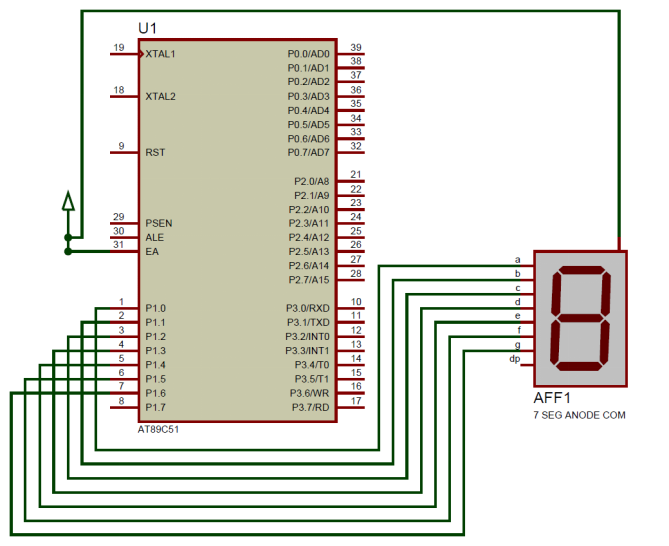Introduction:
Seven-segment displays are commonly used to display numbers and characters in various electronic devices. They are easy to read, low-cost, and consume very little power. Interfacing a seven-segment display with a microcontroller like the 8051 is a simple task that can be accomplished with minimal hardware and software requirements.
In this blog post, we will discuss the basics of seven-segment displays and how to interface them with an 8051 microcontroller.
What is a Seven-Segment Display?
A seven-segment display is a display device consisting of seven LEDs arranged in a specific pattern to display numerals and some letters or symbols. Each of the seven LEDs can be controlled independently to display different combinations of characters. By turning on or off the appropriate LEDs, it is possible to display all the numbers from 0 to 9 and some letters like A, b, C, d, E, F.

The seven segments are labeled as A, B, C, D, E, F, and G. Each segment is connected to a different pin of the display. In addition, there is an eighth pin that controls the decimal point.
Interfacing a Seven-Segment Display with 8051: To interface a seven-segment display with an 8051 microcontroller, we need to connect the segments of the display to the output pins of the microcontroller. We also need to connect the common cathode or anode of the display to a suitable voltage source, depending on the type of display.
For a common cathode seven-segment display, we need to connect the common cathode pin to ground and the segment pins to the output pins of the 8051. For a common anode display, we need to connect the common anode pin to Vcc and the segment pins to the output pins of the 8051.
Once the display is connected to the microcontroller, we can write a program to control the display. We can use the P1 port of the 8051 to connect to the segment pins of the display. To display a number, we need to send the appropriate combination of signals to the segment pins. For example, to display the number 0, we need to turn on all the segments except G. Similarly, to display the number 1, we need to turn on only segments B and C.
Circuit:

Note : in above circuit diagram connect reset circuit to pin number 9 and crystal oscillator 11.0592 to Pin number 18 and 19
Code Example: Here is an example program to display the numbers 0 to 9 on a common anode seven-segment display connected to the 8051 microcontroller:
**************************************************************
#include <reg51.h>
#define SEG_PORT P1
void delay(unsigned int count) {
unsigned int i, j;
for(i=0; i<count; i++) {
for(j=0; j<1275; j++);
}
}
void display(unsigned char num) {
switch(num) {
case 0: SEG_PORT = 0xC0; break;
case 1: SEG_PORT = 0xF9; break;
case 2: SEG_PORT = 0xA4; break;
case 3: SEG_PORT = 0xB0; break;
case 4: SEG_PORT = 0x99; break;
case 5: SEG_PORT = 0x92; break;
case 6: SEG_PORT = 0x82; break;
case 7: SEG_PORT = 0xF8; break;
case 8: SEG_PORT = 0x80; break;
case 9: SEG_PORT = 0x98; break;
default: SEG_PORT = 0xFF; break;
}
}
void main() {
unsigned char i;
while(1) {
for(i=0; i<=9; i++) {
display(i);
delay(500);
}
}
}In this code, we define the SEG_PORT pin using a #define statement. We also define a delay function to add some delay between the display of each number. The display() function is used to display a number on the seven segment display. We use a switch statement to determine which segments of the display need to be lit up for each number. Finally, in the main function, we use a for loop to continuously display numbers 0-9 on the seven segment display, with a delay of 500ms between each number. The while(1) loop is used to keep the program running indefinitely.
Note that this code assumes that the seven segment display is connected to the 8051 microcontroller as follows: the common anode pin is connected to ground, and the 7 segment pins (A-G) are connected to P1. You may need to modify these pins depending on your specific hardware configuration

